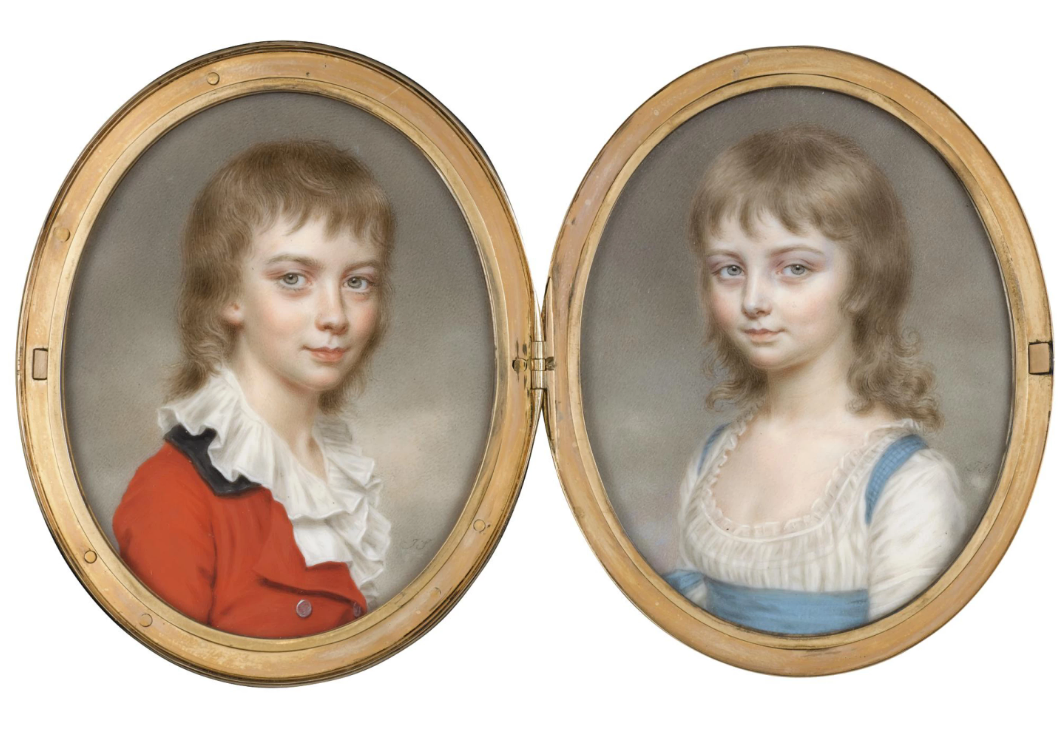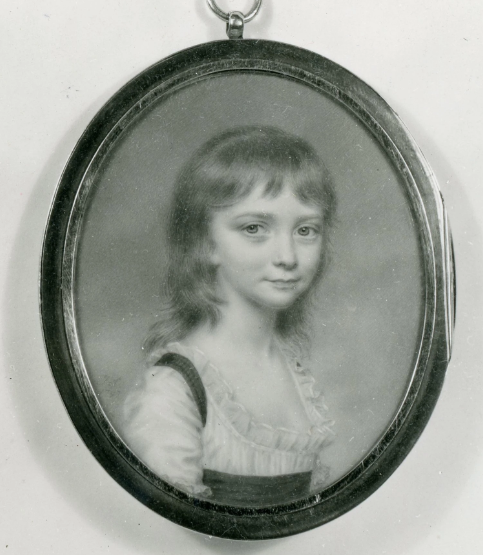Citation
Chicago:
Maggie Keenan, “John Smart, Portrait of a Girl, Possibly Maria Burroughs, 1797,” catalogue entry in Aimee Marcereau DeGalan, Blythe Sobol, and Maggie Keenan, The Starr Collection of Portrait Miniatures, 1500–1850: The Collections of the Nelson-Atkins Museum of Art, vol. 4, ed. Aimee Marcereau DeGalan (Kansas City, MO: Nelson-Atkins Museum of Art, 2025), https://doi.org/10.37764/8322.5.1608.
MLA:
Keenan, Maggie. “John Smart, Portrait of a Girl, Possibly Maria Burroughs, 1797,” catalogue entry. Aimee Marcereau DeGalan, Blythe Sobol, and Maggie Keenan. The Starr Collection of Portrait Miniatures, 1500–1850: The Collections of the Nelson-Atkins Museum of Art, edited by Aimee Marcereau DeGalan, vol. 4, Nelson-Atkins Museum of Art, 2025. doi: 10.37764/8322.5.1608.
Artist's Biography
See the artist’s biography in volume 4.
Catalogue Entry
John Smart painted this portrait of a young girl in 1797, and while her identity remains unknown, she bears some resemblance to members of the Burroughs family. Smart completed drawings of Letitia Burroughs and her four children—William (1784–1814), Letitia (ca. 1786–1832), Louisa (1789–1862), and Maria (ca. 1790–1798)—along with finished works on ivory: The hard white substance originating from elephant, walrus, or narwhal tusks, often used as the support for portrait miniatures. of the children, which are dated 1797.1See Christie’s, London, Sketches and Studies for Miniature Portraits by John Smart, the Property of Mrs. Busteed, Great-Granddaughter of the Artist, December 17, 1936, lot 44: “A Frame, containing a collection of sixteen portraits in pencil, many signed and dated, including the Burroughs Family. . . .” The drawings’ whereabouts are currently unknown. It is unclear whether these portraits were dated.


Portraits of William and Maria (Fig. 1),
and Louisa (Fig. 2) have surfaced at recent auctions,
but Letitia’s miniature has not yet been located. This
absence suggests that the current miniature might be
her missing portrait.2John Smart,
Portraits of William and Maria Burroughs,
ca. 1797, 2 5/8 x 2 1/16 in. (6.6 x 5.2 cm) each,
sold at Sotheby’s, London,
Important Miniatures from a Private
Collection, April 16, 2008, lot 94,
https://www.sothebys.com
The present portrait’s case probably originated from India. Smart brought these types of cases back to London when he returned there in 1795. A dark brown braid decorates the case back, but the hair art: The creation of art from human hair, or “hairwork.” See also Prince of Wales feather. is unlikely to be the sitter’s own whisper-thin locks. She wears her hair down and gazes out at the viewer with doe-like eyes. A speck of black in her left eye may be an artist’s error while painting eyelashes or, more likely, a freckle.4Scleral melanocytosis is another possibility, a congenital condition that causes gray-blue pigmentation in the white of eye and is particularly common in early childhood; see Marc Berger and Alexander Leung, “A Spot in the Eye,” Am Fam Physician 59 (1999): 163–64. For an example of another eye-related condition, see John Smart, Portrait of Keith MacAlister, Colonel of 5th Madras Native Cavalry, 1810. Smart sensitively renders her delicate complexion, faintly suggesting her left collarbone as well as thin blue veins and two additional freckles. She wears a white muslin dress that cinches around her neckline; a purple waistband is barely visible at the frame’s edge.
This work is one of more than a dozen portraits of children in the Starr Collection. Martha Jane Starr had an affinity for collecting portraits of young sitters as her own family grew.5Many of these miniatures of children were illustrated on the cover of Antiques, November 1961. In 1965, the year this portrait was donated to the Nelson-Atkins, Martha Jane’s grandson, James Philip Starr, was born. He would eventually continue the family legacy by donating a trove of Starr miniatures in 2018, including two additional portraits of children (2018.11.3 and 2018.11.5).
Notes
-
See Christie’s, London, Sketches and Studies for Miniature Portraits by John Smart, the Property of Mrs. Busteed, Great-Granddaughter of the Artist, December 17, 1936, lot 44: “A Frame, containing a collection of sixteen portraits in pencil, many signed and dated, including the Burroughs Family. . . .” The drawings’ whereabouts are currently unknown. It is unclear whether these portraits were dated.
-
John Smart, Portraits of William and Maria Burroughs, ca. 1797, 2 5/8 x 2 1/16 in. (6.6 x 5.2 cm) each, sold at Sotheby’s, London, Important Miniatures from a Private Collection, April 16, 2008, lot 94, https://www.sothebys.com/en/auctions/ecatalogue/2008/important-miniatures-from-a-private-collection-l08172/lot.94.html; and John Smart, Portraits of Letitia and Louisa, 1797, 2 5/8 in. (6.6 cm) high each, sold at Christie’s, London, Miniatures and Objects of Vertu, October 26, 1949, lot 114. Louisa’s miniature has resurfaced at the Fondazione Centro Studi Sull’Arte, Lucca, Italy, no. 0007420, https://fototeca.fondazioneragghianti.it/scheda/F/70423.
-
The identification of the sitters in the side-by-side portraits is based upon “inscriptions on the copper backboards of the present lot: ‘Mr / Wm Burroughs / by John Smart / 1797’ [and] ‘Maria / Burroughs / 1797.’” See Important Miniatures from a Private Collection (London: Sotheby’s, April 16, 2008), lot 94.
-
Scleral melanocytosis is another possibility, a congenital condition that causes gray-blue pigmentation in the white of eye and is particularly common in early childhood; see Marc Berger and Alexander Leung, “A Spot in the Eye,” Am Fam Physician 59 (1999): 163–64. For an example of another eye-related condition, see John Smart, Portrait of Keith MacAlister, Colonel of 5th Madras Native Cavalry, 1810.
-
Many of these miniatures of children were illustrated on the cover of Antiques, November 1961.
Provenance
Mr. John W. (1905–2000) and Mrs. Martha Jane (1906–2011) Starr, Kansas City, MO, by 1965;
Their gift to the Nelson-Atkins Museum of Art, Kansas City, MO, 1965.
Exhibitions
The Starr Foundation Collection of Miniatures, The Royal Ontario Museum, Toronto, December 8, 1972–January 14, 1973, no cat., no. 130, as Unknown Young Girl.
John Smart: Virtuoso in Miniature, The Nelson-Atkins Museum of Art, Kansas City, MO, December 21, 2024–January 4, 2026, no cat., as Portrait of a Girl, Possibly Maria Burroughs.
References
Ross E. Taggart, The Starr Collection of Miniatures in the William Rockhill Nelson Gallery (Kansas City, MO: Nelson Gallery-Atkins Museum, 1971), no. 130, p. 46, (repro.), as Unknown Young Girl.
If you have additional information on this object, please tell us more.